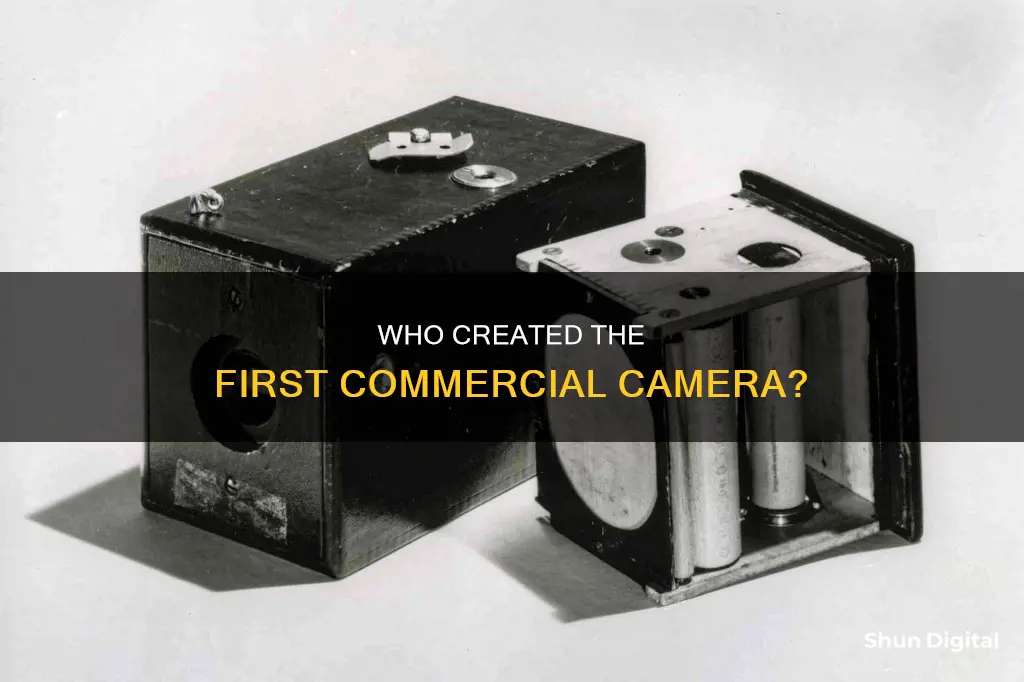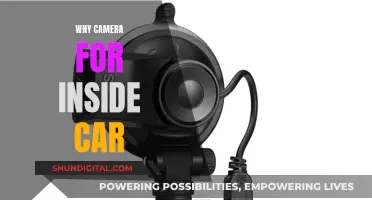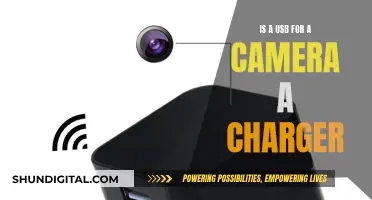
The first commercially made camera was a daguerreotype camera produced by Alphonse Giroux in 1839. It cost 400 francs (approximately $7,000 by today's standards) and had an exposure time of 5 to 30 minutes. This camera was the first to use plates from the shelf, which could be bought in different sizes.
| Characteristics | Values |
|---|---|
| Inventor | Alphonse Giroux |
| Year | 1839 |
| Camera type | Daguerreotype |
| Cost | 400 francs |
| Exposure time | 5 to 30 minutes |
What You'll Learn

The first commercially made camera was a daguerreotype camera
The first daguerreotype camera was produced by Alphonse Giroux in 1839. The camera had an exposure time of 5 to 30 minutes and cost around $7,000 in today's money. It was accessible to the public but was not cheap. The daguerreotype camera was a double-box design, with a landscape lens fitted to the outer box and a holder for a ground glass focusing screen and image plate on the inner box. By sliding the inner box, objects at various distances could be brought into focus. After a satisfactory image was focused on the screen, the screen was replaced with a sensitized plate. A knurled wheel controlled a copper flap in front of the lens, which functioned as a shutter.
The daguerreotype camera formed images on silvered copper plates, and images were only able to develop with mercury vapour. The earliest daguerreotype cameras required several minutes to half an hour to expose images on the plates. However, by 1840, exposure times were reduced to just a few seconds due to improvements in the chemical preparation and development processes and advances in lens design.
Simplisafe Camera Costs: When Do You Get Charged?
You may want to see also

It was produced by Alphonse Giroux in 1839
The first commercially made camera was produced by Alphonse Giroux in 1839. The camera was a daguerreotype camera, and it was the first to use plates from the shelf. The daguerreotype camera was the result of a partnership between Alphonse Giroux, Louis Daguerre, and Isidore Niépce. The camera had an exposure time of 5 to 30 minutes and cost around $7,000 in today's money. It was accessible to the public, but not cheap.
The daguerreotype camera was a significant advancement in camera technology. It used a double-box design, with a landscape lens fitted to the outer box and a holder for a ground glass focusing screen and image plate on the inner box. The inner box could slide, allowing objects at various distances to be brought into sharp focus. After focusing the desired image on the screen, the screen was replaced with a sensitized plate, and a copper flap in front of the lens functioned as a shutter.
The daguerreotype camera represented a shift from experimental cameras to more practical and popular ones. This shift was marked by the use of standardized plates, shorter exposure times, and the ability to capture images without the need for long and complex processes. The daguerreotype camera paved the way for further innovations in camera technology and played a crucial role in making photography more accessible to the public.
Priority Mode: Understanding Camera's Creative Control Feature
You may want to see also

It cost 400 francs (approximately $7,000 by today's standards)
The first commercially made camera was a daguerreotype camera produced by Alphonse Giroux in 1839. It cost 400 francs (approximately $7,000 by today's standards) and was the first camera to use plates from the shelf. The daguerreotype camera was a double-box design, with a landscape lens fitted to the outer box, and a holder for a ground glass focusing screen and image plate on the inner box. The inner box could be slid to bring objects at various distances into focus. The daguerreotype camera was the first mass-marketed camera, and its creation marked a significant leap forward in camera technology.
The daguerreotype camera's exposure time ranged from 5 to 30 minutes, and it was possible to purchase standardized plates in a variety of sizes. The camera was not cheap, but it was more accessible than its predecessor, the heliography camera invented by Joseph Nicéphore Niépce. The heliography camera was mostly experimental and had a multi-day exposure time, limiting its subjects to landscapes.
The daguerreotype camera was a result of a partnership between Alphonse Giroux and Louis Daguerre, the inventor of the daguerreotype process. Daguerre even signed the camera to verify its authenticity. The cameras produced by Giroux were more opulent than those of his competitors, and the selling price of 400 francs was very high, representing approximately the annual income of an average working man at the time.
The daguerreotype camera was also the first camera to be mass-produced. While there is no record of the total number of cameras produced by Giroux, it is assumed that the numbers were limited due to the quick emergence of cheaper and improved cameras. The daguerreotype camera played a crucial role in the history of photography, paving the way for future innovations and making photography more accessible to the masses.
Charging the Polaroid Snap Touch: A Step-by-Step Guide
You may want to see also

It had an exposure time of 5 to 30 minutes
The first commercially made camera was a daguerreotype camera produced by Alphonse Giroux in 1839. It had an exposure time of 5 to 30 minutes and cost around $7,000 in today's money. It wasn't cheap, but it was accessible.
The daguerreotype camera was the first mass-marketed camera, and it played a significant role in the history of photography. The camera used standardized plates that could be purchased in different sizes, making it more versatile than previous models. Despite its long exposure time, the daguerreotype camera was a popular choice for photographers due to its accessibility and the ability to capture images with permanent plates.
The daguerreotype camera was a result of the collaboration between Joseph Nicéphore Niépce and Louis Daguerre. Niépce is credited with creating the first camera in 1816 and experimenting with various substances to capture images. Unfortunately, he passed away in 1833, before the daguerreotype camera was introduced. Daguerre continued their work and made improvements to the camera, eventually leading to the first mass-produced device.
The daguerreotype camera used a process where a plate with a thin film of silver iodide was exposed to light for minutes or hours. The plate was then treated with mercury vapour and chemically treated to become insensitive to light. This process fixed the image and made it permanent.
The daguerreotype camera was followed by other innovations in photography, such as the calotype, which used paper soaked in table salt and brushed with silver nitrate. However, the daguerreotype camera remained a significant milestone in the evolution of photography and the development of commercial cameras.
Clarity Slider: Enhancing Your Photos' Local Contrast
You may want to see also

It was the first mass-marketed camera
The first mass-marketed camera was a daguerreotype camera produced by Alphonse Giroux in 1839. It cost 400 francs (approximately $7,000 by today’s standards). This consumer camera had an exposure time of 5 to 30 minutes, and you could purchase standardized plates in a range of sizes.
The daguerreotype camera was the first to be mass-produced and sold to the public. It was a significant milestone in the history of photography, marking the shift from experimental cameras to commercially available devices.
The daguerreotype camera used standardized plates that could be purchased separately, making it more accessible to those interested in photography. The exposure time of the camera was between 5 to 30 minutes, which was a common duration for early photographic cameras.
The daguerreotype camera played a crucial role in popularizing photography and making it more widely accessible. It sparked a shift from photography being a niche pursuit to becoming a more common activity for enthusiasts and amateurs.
The camera's design and functionality were innovative for its time. It had a double-box structure, with a landscape lens attached to the outer box and a holder for a ground glass focusing screen and image plate within the inner box. This design allowed for easy adjustment of focus by sliding the inner box.
The daguerreotype camera's impact extended beyond just the realm of photography. It influenced the work of artists, particularly those who utilised the camera obscura for drawing and painting. The camera's ability to capture and preserve images permanently inspired new ways of seeing and representing the world.
The daguerreotype camera also had limitations. The long exposure times made it challenging to capture moving subjects or spontaneous moments. Additionally, the images produced were susceptible to fading over time. Despite these drawbacks, the daguerreotype camera represented a pivotal step in the evolution of photography, paving the way for further innovations and improvements in camera technology.
The Keystone K7 Camera: A Rare Vintage Find
You may want to see also
Frequently asked questions
The first commercially made camera was made by Alphonse Giroux in 1839.
The first commercially made camera was a daguerreotype camera.
The first commercially made camera cost 400 francs, which is approximately $7,000 in today's money.







